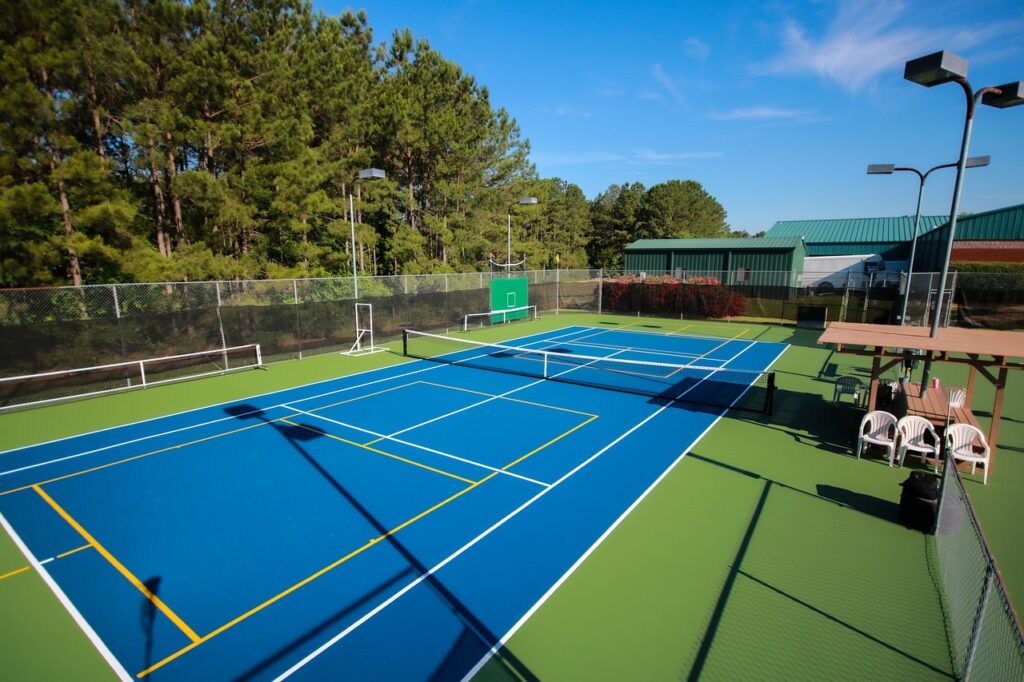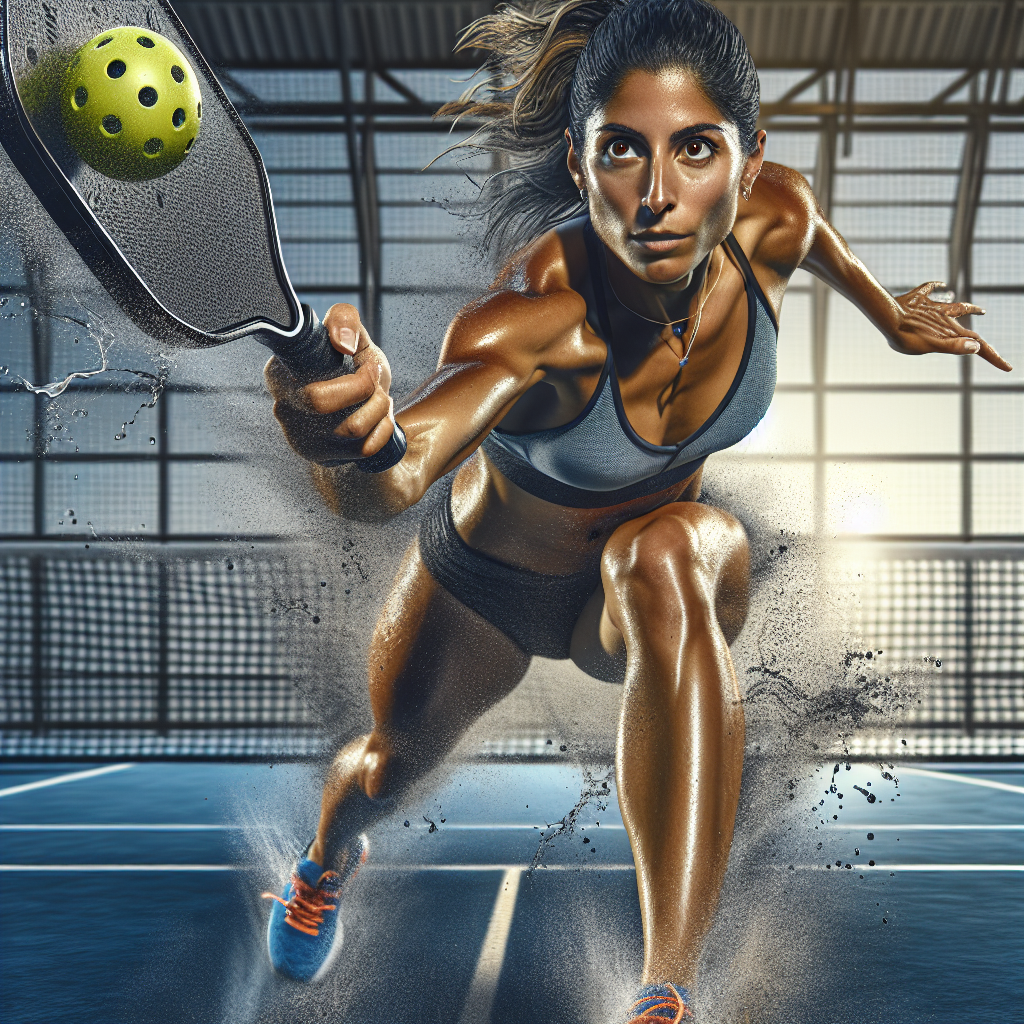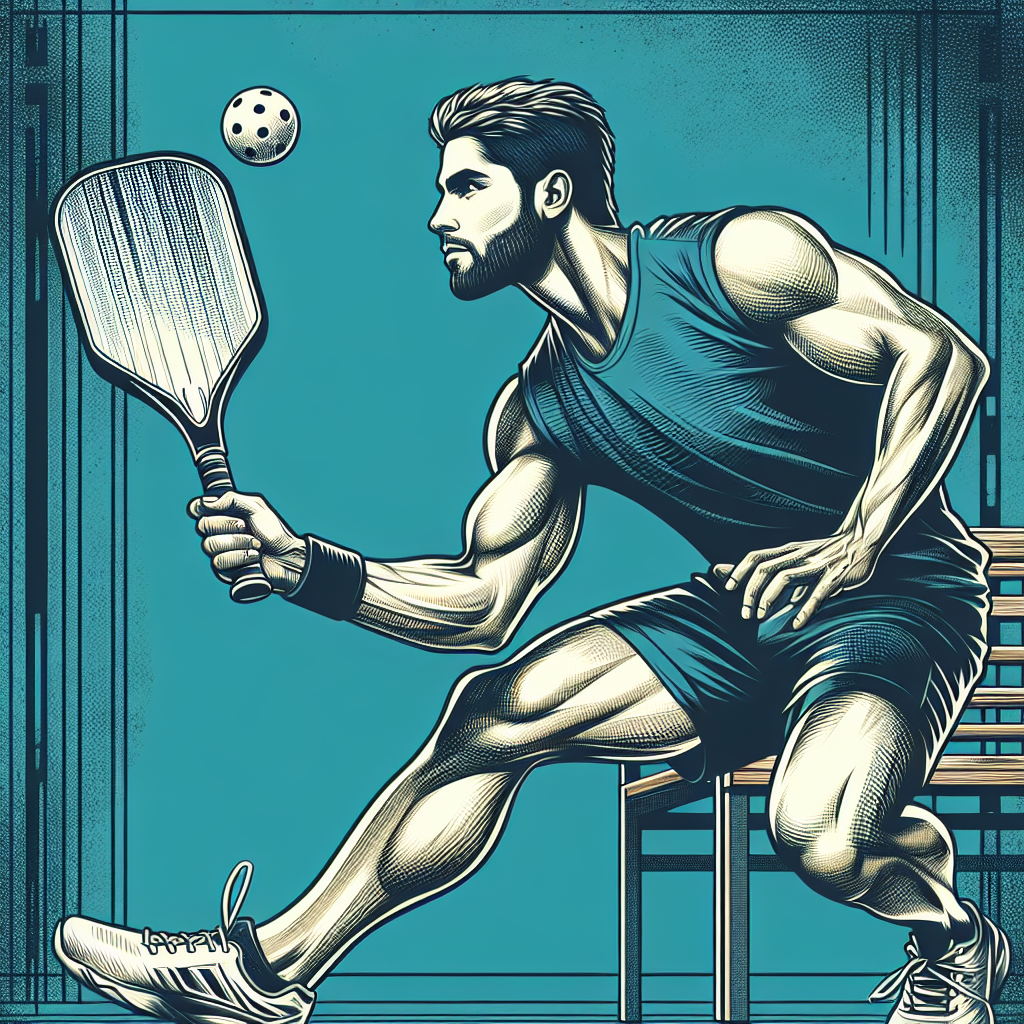If you’re looking to learn how to play pickleball singles, you’ve come to the right place! This engaging sport is a combination of tennis, badminton, and table tennis, played with a paddle and a lightweight ball on a smaller court. In pickleball singles, it’s just you against your opponent, working on improving your skills while enjoying some friendly competition. This article will provide you with some essential tips and strategies to help you excel at pickleball singles and have a blast on the court. Let’s get started!

Basic Rules
Pickleball is played on a court that is divided by a net into two sides. The court dimensions are similar to those of a badminton court, measuring 20 feet wide and 44 feet long. The game is played with a plastic ball, specifically designed for pickleball, and paddles made of graphite or composite materials.
The Court
The pickleball court is divided into four sections: two serving areas and two receiving areas. The serving areas are diagonally opposite each other, with the net running through the middle. Each side of the court is further divided into a non-volley zone or “kitchen” that spans 7 feet from the net. It is essential to understand these court divisions to adhere to the rules of the game.
Scoring
Scoring in pickleball is straightforward. Each game is usually played to 11 points, with the winning team or player needing to have a two-point advantage. To begin the game, the serving team is decided through a coin toss or other means. Points can only be scored by the serving team. If the serving team fails to win the point, the serve switches to the opposing team. Games are typically played in a best-of-three format.
Serving
Serving in pickleball is underhand and must be made diagonally across the court, starting from the right-hand side of the server and going to the right-hand side of the receiver. The server must keep one foot behind the baseline and within the sideline. The serve should be executed below waist level, and the paddle must make contact with the ball below the server’s waist.
Return of Serve
When receiving the serve, the player on the receiving team should stand behind the non-volley zone. The return of serve should be made after the ball bounces once on the receiver’s side. The ball can be returned with either a forehand or backhand stroke, and aim to get the ball over the net and into the opposing team’s court.
Gameplay
Starting the Game
To start the game, the serving team must decide which side they will serve from. Once the decision is made, the server from the first team begins the game by serving the ball diagonally. The receiver must let the ball bounce once before returning it. The serve then alternates sides until a fault occurs or a point is scored.
Serving Techniques
There are various serving techniques in pickleball that you can utilize to gain an advantage. Some common techniques include the deep serve, which is aimed towards the back of the court to push the receiver further away from the net. The soft drop serve, on the other hand, involves a gentle drop shot over the net to catch the receiver off-guard. Experiment with different serving techniques to find what works best for you.
Return Techniques
Returning the serve is crucial to maintain control and put the serving team on the defense. Some popular return techniques include the cross-court return, where you aim to hit the ball diagonally back to the opposite side of the court. The lob return involves hitting the ball high and deep to force the serving team to retreat. Mastering different return techniques is key to keeping your opponents guessing.
Positioning on the Court
Proper positioning on the court is essential for effective gameplay. When serving, the server should be positioned behind the baseline and within the sideline. The receiver should be positioned behind the non-volley zone. As the game progresses, players should move strategically to maintain balance and cover all areas of the court. Effective positioning allows for better shot selection and increased chances of winning points.
Strategies
Stay in Control
One strategy to excel at pickleball is to stay in control of the game. This means playing smart shots, avoiding unnecessary risks, and maintaining a steady pace. Instead of going for overly aggressive shots, focus on maintaining a consistent and controlled game. Being patient and waiting for the right opportunities to attack can lead to more successful shots and improve your overall game.
Hit to Weaknesses
Another effective strategy in pickleball is to identify and exploit your opponent’s weaknesses. Observe their gameplay and look for patterns or areas where they struggle. By targeting their weaknesses, whether it be their backhand stroke or their vulnerability at the net, you can increase your chances of winning points and ultimately the game. Remember to stay respectful and fair while executing this strategy.
Vary Your Shots
To keep your opponents on their toes, it is crucial to vary your shots. Mix up your serves, returns, and general shot selection to keep your opponents guessing and off-balance. By incorporating different types of shots, such as lobs, drives, and dinks, you can catch your opponents off-guard and force them into making defensive plays. This strategy can disrupt your opponent’s rhythm and give you the upper hand in the game.
Communication with Your Partner
If you’re playing doubles pickleball, effective communication with your partner is vital. Ensure that you and your partner are on the same page regarding shot selection, positioning, and overall strategy. Maintain clear and concise communication, especially during fast-paced exchanges, to avoid confusion and maximize your teamwork. By working together as a cohesive unit, you can enhance your chances of success on the court.
Footwork
Ready Position
Maintaining the correct ready position is essential for good footwork in pickleball. To achieve this, stand with your feet shoulder-width apart and your knees slightly bent. This position allows you to move quickly in any direction and be ready to respond to your opponent’s shots. By staying light on your feet and always being in the ready position, you can effortlessly react to the game’s fast-paced nature.
Moving Side to Side
Effective footwork in pickleball requires the ability to move swiftly from side to side. Practice shuffling your feet side to side to cover a wider range and reach shots that are farther away. By mastering this movement, you can effectively cover the court and limit your opponent’s scoring opportunities. Remember to stay balanced and keep your weight centered to ensure better control and agility.
Moving Forward and Backward
In addition to lateral movement, being able to move forward and backward is crucial in pickleball. This is particularly important when playing at the net or responding to deep shots from your opponents. Practice quick and controlled steps to move forward and backward, ensuring you are in the optimal position to return shots and maintain control of the game. Focusing on footwork can greatly enhance your overall performance on the court.
Cross-Step
Another footwork technique commonly used in pickleball is the cross-step. This step allows you to cover more ground quickly while maintaining balance. To execute a cross-step, step with your left foot if the ball is on the right side of the court or vice versa. This movement allows you to generate power for shots and effectively change direction on the court. Incorporating the cross-step into your footwork routine can greatly improve your agility and performance.

Shot Selection
Dinks
Dinks are short, soft shots played close to the net. They are an excellent shot selection when you want to control the pace of the game and force your opponents to make difficult shots. To execute a dink, use a gentle tapping motion to drop the ball just over the net. Dinks are often aimed at the non-volley zone, making it challenging for your opponents to execute an aggressive shot.
Drives
Drives are powerful shots played with more speed and intent. These shots are typically aimed deep into your opponent’s court, forcing them to retreat and play defensively. To execute a drive, use a firm swing and aim for a low and fast shot at your opponent. Drives are effective in creating openings for attacking shots and putting your opponents under pressure.
Lobs
Lobs are high shots aimed to send the ball over your opponent’s head and deep into their court. Lobs are particularly useful when your opponents are positioned close to the net, as it forces them to move backward and makes it more challenging for them to return the shot effectively. Use a gentle swing and aim high to execute a successful lob shot.
Smashes
Smashes are powerful shots played from a high position and aimed to hit the ball downward with force. Smashes are often used in response to a high lob shot or weak returns. To execute a smash, position yourself correctly and use an overhead swinging motion to hit the ball with power and precision. Smashes can be intimidating to opponents and can quickly shift the momentum in your favor.
Net Play
Approach Shots
Approach shots in pickleball involve approaching the net quickly after your opponent’s shot to take control of the volley. This strategy allows you to position yourself in a dominant position and put your opponents on the defensive. To execute an approach shot, move forward quickly after your opponent’s shot and aim to hit the ball before it bounces. By using this technique, you can maintain control and dictate the pace of the game.
Volleys
Volleys are shots that are hit in the air before the ball touches the ground. These shots are commonly used during fast-paced exchanges at the net. To execute a volley, position yourself near the net and have your paddle ready to strike the ball as soon as it comes to your side of the court. Keep your strokes compact and controlled to ensure accuracy and reduce the risk of errors.
Drop Shots
Drop shots are shots that are aimed to barely clear the net and then bounce close to it, making it difficult for your opponent to reach the ball. Drop shots are particularly effective when your opponents are positioned farther away from the net. To execute a drop shot, use a gentle touch and aim to hit the ball softly with minimal force. This shot can catch your opponents off-guard and force them into a defensive position.
Blocking
Blocking in pickleball involves using your paddle to redirect the ball without making a full swing. This technique is useful when your opponents hit powerful shots and you want to respond with a controlled shot. To block effectively, position yourself near the net with your paddle slightly turned, ready to deflect the ball. Use a firm but controlled touch to guide the ball where you want it to go. Blocking allows you to regain control of the point and use your opponents’ power against them.

Defensive Techniques
Recovering from Lobs
When faced with a lob shot, it is crucial to react quickly and recover to a defensive position. If the lob is high and deep, move backward quickly while keeping your eyes on the ball to track its trajectory. Position yourself to the best of your ability to return the shot, either with a lob of your own or by regaining control of the point.
Dealing with Power Shots
When faced with powerful shots from your opponents, it is important not to panic. Stay focused and use your paddle to control the shot rather than swinging forcefully. Blocking is a useful technique to redirect the ball and regain control. Anticipate where the shot is headed and position yourself accordingly to respond effectively.
Neutralizing Powerful Serves
Receiving powerful serves can be challenging, but there are ways to neutralize them. Position yourself further back in the court to give yourself more time to react. Focus on returning the serve reliably and accurately. Use controlled shots and aim for good placement to avoid giving your opponents an advantage. Remember to maintain good footwork to cover the court effectively.
Anticipating Opponent’s Strategy
Having the ability to anticipate your opponent’s strategy can greatly improve your defense. Observe your opponent’s patterns and shot selection to predict their next move. Reading their body language and watching their racket can give you valuable insights into their intentions. By staying one step ahead and anticipating their shots, you can position yourself well and respond effectively.
Game Variations
Speed Pickleball
Speed pickleball is a variation that focuses on fast-paced exchanges and quick reactions. The game is played with a smaller court and a faster pace, making it more challenging and exciting. Speed pickleball is an excellent way to improve your reflexes and agility on the court.
Angle Pickleball
Angle pickleball is a variation that emphasizes making shots at different angles to throw off your opponents. Instead of hitting the ball straight down the line or cross-court, players aim to hit shots at various angles, making it harder for their opponents to predict and return.
King of the Court
King of the Court is a game variation where players rotate positions after each point is scored. The player who wins the point becomes the king and gets to stay in their position while the other players rotate. This variation allows players to experience different positions and challenges throughout the game.
Mini Tennis Variation
The mini tennis variation of pickleball is played with a smaller court and lower net. This variation is often used for beginners or players looking for a more relaxed and casual game. Mini tennis allows for longer rallies and helps players develop their skills before transitioning to a full-sized court.

Equipment
Pickleball Paddles
Pickleball paddles are an essential piece of equipment in the game. They come in various materials, including graphite, composite, and wood. Consider factors such as weight, grip, and paddle face texture when choosing the right paddle for your playstyle. Try different paddles to find the one that feels comfortable and suits your game.
Pickleballs
Pickleballs are specialized balls designed specifically for pickleball. They are similar to a wiffle ball, with small holes to reduce air resistance and increase overall playability. Pickleballs come in different colors, and some can be indoor or outdoor specific. Check the rules and regulations of the venue or organization you’re playing with to ensure you’re using the appropriate ball.
Appropriate Clothing and Shoes
When playing pickleball, wearing appropriate clothing and footwear is crucial for comfort and safety. Opt for lightweight and breathable clothing that allows for ease of movement. Consider wearing athletic shoes with good traction and support to prevent slips and falls on the court. Stay hydrated and protect yourself from the sun’s rays by wearing sunscreen and a hat when playing outdoors.
Optional Accessories
In addition to the essential equipment, there are optional accessories that you can consider. Pickleball gloves can provide extra grip and reduce strain on your hands during gameplay. Sunglasses can protect your eyes from the sun and improve visibility on the court. Arm sleeves and compression gear can offer additional support and enhance performance. Explore different accessories to find what works best for you.
Etiquette and Sportsmanship
Respecting the Rules
Respecting the rules of pickleball is crucial to maintain fairness and integrity in the game. Familiarize yourself with the rules and ensure you adhere to them throughout your gameplay. When in doubt, ask for clarification or consult official rulebooks. By playing by the rules, you contribute to a positive and enjoyable pickleball experience for everyone involved.
Good Sportsmanship
Good sportsmanship is a fundamental aspect of any sport, including pickleball. Treat your opponents with respect, regardless of the outcome of the game. Celebrate good shots made by both sides and avoid gloating or taunting. Practice humility in victory and grace in defeat. Remember that pickleball is meant to be fun and inclusive, and maintaining good sportsmanship contributes to a positive playing environment.
Courtesy to Opponent
When playing pickleball, always extend courtesy to your opponent. Avoid distracting or unsportsmanlike behavior, such as loud noises, excessive celebrations, or intentionally hindering your opponent’s shots. Maintain a positive and friendly attitude during the game, and offer a handshake or a kind word at the end of the match. By showing respect to your opponent, you contribute to the overall enjoyment of the game.
Clear Communication
Clear communication is key, both with your partner and your opponents. Keep communication concise and avoid excessive chatter during gameplay. Communicate your intentions or strategy to your partner using simple and decisive language. When in doubt, ask for clarification or discuss any issues that may arise. Effective communication can minimize misunderstandings and contribute to better teamwork and gameplay.
In conclusion, pickleball is an exciting and accessible sport that combines elements of tennis, badminton, and table tennis. By understanding the basic rules, developing important skills, and employing effective strategies, you can improve your pickleball game and have a great time on the court. Remember to practice good sportsmanship and have fun while playing this enjoyable and fast-growing sport!


